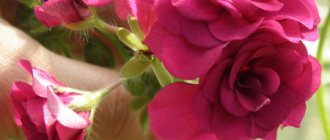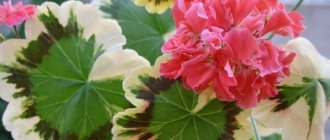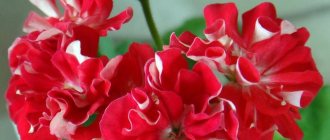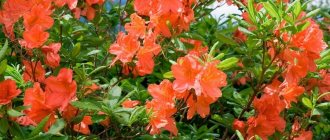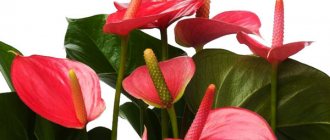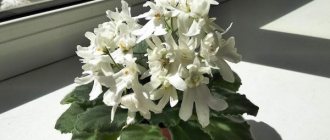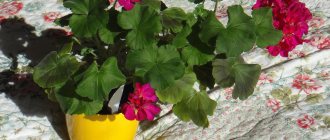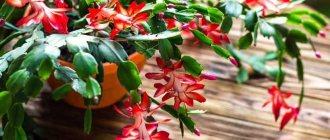Varieties
Pink pelargoniums have many varieties, each of which is particularly beautiful.
Many people call them “Pink Pearls”. Almost all of them have thin shoots and are ampelous. Pink Rambler. This is a fairly common species, with a two-tone color that slightly resembles the inflorescences of soft pink roses. It can grow up to half a meter in height. The leaves emit a specific smell, and essential oils are often made from them. Flowering is relatively long, beginning in spring and continuing until early autumn. The inside of the flowers is pink, and the outer part is white. This type of pelargonium can withstand temperatures up to +14 degrees. If it is lower, the plant begins to get sick.
The stem of this plant is quite flexible, and the soft green leaves with a corrugated border especially highlight the beauty of the flowers. The buds rarely open completely.
External features
Peony pink hawaiian coral (paeonia pink hawaiian coral)
Pelargonium Australian pink is distinguished by its exquisite decorative qualities. Its buds have the correct shape of a pink bud that has not fully opened.
Note that in addition to its beautiful shape, the bud itself in this case is also quite large, which makes the overall appearance of the plant even more decorative.
The leaves have a standard green color, but in this case they are quite bright, which is a beautiful frame for the buds. The inflorescences are large, the shoots are quite tall. The petals have a rich pink color, further increasing the resemblance of this pelargonium to a bush rose. The Australian pink bush itself is quite powerful and strong, tall, and usually has many lateral branches.
Features of reproduction
Cuttings
Pelargonium apple blossom rosebud
This simple propagation process is carried out as follows:
- Prepare a sharp knife and first disinfect it with alcohol. Do not use a blunt instrument, as it will damage the tissue of the planting material and slow down the growth of future roots.
- Cuttings are cut from shoots that are directed at right angles to the main one. They must have at least 3 leaves.
- The length of the cutting should be 5-7 cm.
- The cut is made at right angles to the stem.
- Place the cutting on a dry cloth for 2 hours to allow the cut area to dry.
- Plant the plant in separate pots filled with nutrient soil with drainage.
Seeds
This method of reproduction has its own characteristics:
- Sowing time. It is best to sow seeds at the end of January - end of February, when additional lighting is not required.
- Selection of planting material. Healthy seeds should be large, dense, oblong in shape and brown in color.
- Soil preparation. To prepare a nutrient substrate, you need to mix the following components:
- peat – 1 part;
sand – 1 part;
- land - 2 parts.
- Temperature. If the seedlings grow at a temperature of no more than 18 degrees, they will not stretch upward. The optimal value remains no higher than 22 degrees.
The prepared soil mixture must be calcined in the oven for 2-3 minutes.
Planting process:
- place the seeds on the ground maintaining a distance of 5 cm from each other;
- sprinkle them with a thin layer of earth - 2 mm;
- water the seedlings with water from a spray bottle;
- cover the container with polyethylene;
- Every day the film must be opened for ventilation;
- after 14 days, the film is removed as seedlings appear;
- After the formation of 2-4 leaves, the seedlings are planted.
We advise you to familiarize yourself with our materials about the features of growing, propagating and caring for other species and varieties of pelargonium: Zonartik, Prince Gustav, Mildfield Rose, Patricia Andrea, Salmon, Lady Gertrude, Bold, Clara Sun, as well as Richard Hudson.
Pelargonium Australianan is a beautiful plant that is grown on the balcony, in open ground and indoors. Despite its spectacular appearance, the flower is completely easy to grow, which even a novice gardener can do.
Pelargonium Pink Rambler
You save: 40 ₽
For all planting material
Dozens of payment methods
Fast and convenient delivery
Russian Post (Moscow and region within 24 hours), SDEK, Courier
Pelargonium Pink Rambler (Pink Rambler).
Zonal rosebud standard pelargonium. The flowers are miniature roses. The color is red-raspberry with a light back side. It branches well and forms a fluffy bush.
Planting pelargonium: Even a novice gardener can plant pelargonium in the garden - the process does not require compliance with any complex rules. You just need to remember about the long roots of the plant when digging holes about 20 cm deep. When planting, it is better to leave a distance of 20-30 cm between the bushes.
Caring for pelargonium: Pelargonium requires systematic moderate watering: the soil should not be allowed to dry out or there should be a large amount of moisture in the soil. The flower does not need spraying. Garden varieties of pelargonium do well in partial shade; flowering is weak in direct sunlight. Therefore, on particularly hot days, darkening is required. The optimal air temperature for garden plants is no more than +20 °C.
Soil for planting: Pelargonium Pink Rambler (Pink Rambler) is quite demanding on the soil. The ideal solution is unused, loose soil with good drainage. For young plants without a formed root system, light soil is more suitable, so sand and peat, vermiculite and perlite are added to the composition. The soil for planting must be sufficiently fertile and well-drained. Pelargonium should not be planted in loamy and clayey soils.
Preparing for winter: Already in the fall, the pot with the plant is placed in a cool and dimly lit place. A southern or northern window sill in a house/apartment is quite suitable for this, since there is diffused sunlight there. And to make up for the lack of light at this time, you can use fluorescent lamps. The optimal daylight hours are 12 hours.
Planting location: The ideal location in the garden for Pink Rambler pelargonium will be in sunny areas. However, even in partial shade it is able to fully develop and bloom profusely throughout the season.
Reproduction of pelargonium by cuttings: You need to prepare a sharp knife or scalpel and disinfect it with alcohol. In no case should you use a blunt instrument, as this can damage the tissue of the cuttings and slow down the growth of future roots. Cuttings are cut from shoots directed at right angles to the main one, and at least 3 leaves should grow on them. For tall varieties of geranium, the length of the cuttings should be about 5-7 cm, for short and miniature varieties - 2.5-4 cm. The cut is made at right angles to the stem.
How to care for Australian Pink Rosebud at home
Pelargonium
Despite the fact that pelargonium Australian rosebud is considered an unpretentious plant, it still requires some care. If you follow the rules, the plant will develop well and will delight you with abundant flowering.
Illumination and temperature conditions
This variety of pelargonium tolerates moderate or warm temperatures well. Initially, the crop was bred in order to grow it at home or in greenhouses.
A comfortable temperature for Swanland pink pelargonium is not lower than 10 °C. In the summer months, you can take the container with the plant outside or onto the balcony, but as soon as the cold starts, the crop is brought back into the warmth.
Note! The plant loves bright places, but does not accept direct sunlight. Strong light can cause burns on leaves and buds, which will lead to various flower diseases
Therefore, it is recommended not to leave the pot of pelargonium on the southern windows, or in the very heat you will have to shade it from the sun.
Watering rules and humidity
Swanland pink geranium bushes like moderate watering. It is recommended not to allow the soil to dry out, but strong humidity will not benefit the crop. Water for irrigation must be warm (the plant is heat-loving). Using cold water will cause the root system to begin to hurt and rot.
Before watering, make sure that the top layer of soil is dry. Overmoistening is fraught with the development of rotting and increases the risk of damage to the flower by fungal diseases.
Important! In summer, the plant is watered more often; in winter, the amount of irrigation is reduced
This variety blooms very beautifully
Fertilizing and soil quality
Pelargonium rosebud prefers loose and nutritious soil
It is recommended to pay special attention to the acidity of the soil; you should choose neutral
If you wish, you can make a suitable soil yourself. To do this, mix turf, peat and humus in a ratio of 4:2:2, respectively. Then add one part each of perlite and sand to loosen it.
Important! It is definitely worth calcining the soil before planting a flower to clear it of parasites and pests. Fertilizing accelerates growth and stimulates long and abundant flowering
It is better to start applying fertilizers in the spring. The feeding procedure is repeated once every 2-3 weeks.
Fertilizing accelerates growth and stimulates long and abundant flowering. It is better to start applying fertilizers in the spring. The feeding procedure is repeated once every 2-3 weeks.
To speed up the growth of bushes, fertilizers containing nitrogen are used, as a result, more leaves are formed on the shoots. As soon as the buds begin to appear, they switch to fertilizing with phosphorus and potassium. In this case, the inflorescences will be more lush and beautiful.
Flowering lasts all summer
Flower container size
Initially, a small pot is chosen for Australian pelargonium. However, with the next transplant, a larger container is taken. This is required so that the plant does not grow, but begins to bloom.
Pruning and replanting
The plant grows quite quickly and requires transplanting into another container. It is better to carry out the procedure in the spring, while pelargonium is still at rest.
Note! After the transplant is carried out, the crop is not fertilized for about a month and a half. It is recommended to carefully monitor soil moisture
Before the onset of winter, pelargonium is transplanted into a pot and transferred to a warm room.
The side shoots of Australian pink pelargonium are often pruned. This procedure allows you to form a beautifully shaped bush, stimulate the formation of new shoots and buds, and get rid of damaged and diseased parts of the plant.
A lush bush can be obtained by pinching the tops of young shoots. To ensure that the crop blooms profusely, faded buds are removed.
Planting and maintaining pelargonium
Pelargonium Apple Blossom Rosebud
When planting the Australian Pink pelargonium variety, you should take into account the fact that it does not tolerate direct sunlight on its leaves. This flower variety prefers partial shade. Even direct rays of the morning sun can cause burns to the flower, and, accordingly, other diseases associated with decreased immunity. If the plant is on the south side, it is important not to forget to create shade during the midday period.
Pelargonium Swanland Pink does not tolerate low air temperatures. Temperatures below 10°C can be detrimental to the flower. Since the variety was bred in a warm country, it is not surprising that it develops well at average temperatures.
Planting pelargonium
The soil for planting this variety of pelargonium must be nutritious and loose. The looseness of the soil ensures proper air exchange necessary for the plant’s root system.
Note! The soil must be neutral. With increased or decreased acidity, the plant will bloom poorly or not bloom at all. Land can be purchased in specialized stores, or you can make it yourself. The soil should consist of turf, peat and perlite in a ratio of 4:2:1.
In the spring, pelargonium australien pink rosebud needs fairly frequent feeding. They are deposited once every two weeks. In order to increase the lushness of the leaves, Australian pelargonium should be fed with nitrogenous fertilizers. When the first buds appear, geranium needs potassium and phosphorus.
Feeding pelargonium
Pelargonium Australian Rosebud develops quite intensively, so it needs frequent replanting. Basically, they are done in order to divide the plant’s root system into several, thereby relieving it. With each subsequent transplant, the planting container should be larger than the previous one.
Pelargonium pink rosebud needs to be pinched and trimmed. Only in this case can a beautiful bush shape be formed.
Important! Pinching provokes intensive appearance of side shoots.
In September, the plant begins to prepare for winter. During this period, it is recommended to reduce the frequency of watering and completely abandon any fertilizing. Geranium remains in a period of suspended animation until the end of winter. As soon as the day becomes longer than the night, the plant leaves hibernation.
Basic rules of care
Pelargonium: a southern beauty for home and garden
In order for pelargonium to please everyone with its flowering in the house for as long as possible, it is necessary to study some growing technologies. Since this plant is southern and accustomed to the scorching rays of the sun, then, of course, it will suffer if abundant watering is provided. Once a week is enough to water the plant. In addition, all excess water must be poured out of the pan so that the roots do not fester. In winter, this procedure should be reduced to once every two weeks.
To avoid stagnation of water, you need to put a thick layer of drainage in the flowerpot, and choose a lighter soil.
You can also make it yourself, for which you just need to mix 1 part sand, 1 part peat, and 1 part leaf humus. It is better to take a small pot so that the pelargonium blooms more luxuriantly.
This plant loves a lot of light, so it is best placed on the south side of the house. If this is not done, the flowers will become smaller and the plant will stop producing essential oils. In addition, you need to know that daylight hours should be at least sixteen hours. Therefore, in winter it is necessary to extend it with the help of fluorescent lamps.
Do not forget about the temperature, which should be within 26 degrees. At the same time, it is better to keep the humidity in the room within 55 percent. It is enough to feed pelargonium once a month. Mineral fertilizers that contain a lot of nitrogen are suitable for this.
Description of appearance and features
The flower is distinguished by impressive inflorescences consisting of double flowers . There are so many of them that their petals cannot open fully. In addition to flowers, the bush has beautiful decorative leaves, which have a bright green color, and a contrasting border runs along the carved edge.
Pelargonium Australianan is a subshrub whose height is 0.6-0.8 and. It has dense and drooping leaves, as well as inflorescences firmly seated on peduncles. The petals have a soft pink color.
You can take a closer look at pelargonium Australian Pink Rosebud in this video:
History of selection
Pelargonium Rosebudnaya has recently become increasingly popular not only among collectors of rare varieties of flowers, but also among novice gardeners. The thing is that in terms of external parameters it is similar to roses. This is a group of zonal pelargoniums that have certain differences from other varieties. Double flowers of this group of plants have many petals, which do not allow the flower to fully bloom, because of this, the half-opened bud visually resembles a rose flower.
Pelargonium Swanland Pink is a decorative flower that came to Russia from Australia. A variety with fairly large peduncles that can stay on the stem for a month if the optimal temperature conditions are observed. Based on the name, it is clear that the color of this plant is soft pink. It can bloom about 3 times per season. The number of peduncles depends on the correct care and maintenance of the flower. The variety was bred by botanist Arthur Langley Smith in 1827. The variety was obtained as a result of selection of curly pelargonium and shiny geranium.
Pelargonium Swanland Pink
Pelargonium Swanland Pink (Australian Pink Rosebud) - what kind of hybrid variety is this
Pelargonium Swanland Pink is one of the crops that can easily be grown at home or in the garden. The plant blooms all summer, but does not tolerate frost, so it must be dug up for the winter. In nature, you can find a similar culture in Africa. The flower appeared in Europe only in the 17th century.
What pelargonium Australian Pink Rosebud looks like
Brief description and origin story
Pelargonium rosebud is very popular among many gardeners. The plant came to Russia from Australia. The selection of the crop was carried out purposefully. In 1827, botanist A. L. Smith crossed curly pelargonium and shiny geranium. As a result, a new flower appeared - pelargonium Australian Pink Rosebud.
The main feature of the plant is its large inflorescences with double flowers. Due to the huge number of flowers, the petals are often not able to fully open. The buds do not fall off for a long time. Up to 5 inflorescences are formed on one branch.
For your information! The petals are terry; on the outside they have a lighter color than on the inside.
Pelargonium Australiana is a small shrub, but quite powerful with a large number of side shoots. The dark green leaves are dense and have a small edge.
The petals on the flowers have a pink color, which is quite rich. Because of it, the culture takes on a special resemblance to rose bushes.
Plants are perennials that are unpretentious to the type of soil and water quality.
The plant is grown in pots and greenhouses, sometimes outdoors
Why doesn't it bloom?
When buying ivy-leaved pelargonium in a store, they are often assured that it blooms profusely and pleases the eye every season. Believing the sellers' words, you bring the flower home and soon notice that the flower does not bloom, but only climbs up. One of the reasons may be incorrect soil composition. Sandy soil is good for growing this type of plant. Pelargonium will not bloom in peat soil due to poor air permeability. If your ivy pelargonium is in peat soil, then it should be replanted. If the passage of moisture and air is poor, the root system can rot and lead to the loss of the flower.
Another reason could be improper placement of the plant. If a flower lacks abundant light and sunlight, then what kind of flowering can we even talk about? Help pelargonium “live” and give it some warmth.
Pelargonium and geranium - the same thing or not
Pelargonium rosebud: description of varieties and care features
Pelargonium and geranium are very similar in appearance. However, they have differences:
- they cannot be crossed because they are genetically different;
- geranium comes from the northern regions, so it tolerates frost well;
- pelargonium is an inhabitant of southern countries; in winter it should be kept in a greenhouse or at home;
- Pelargonium is grown on balconies, geranium can feel great in the garden, that’s the difference.
The unpretentiousness of geranium and its high decorative qualities have led to the wide distribution of the plant among flower growers. Properly selected conditions for its growth make it possible to enjoy beautiful and long-lasting flowering.
How to grow Pac Viva Rosita and care for the flower
In order for Rosita pelargonium to fully develop, it needs proper care.
Illumination and temperature conditions
The plant needs sufficient light. However, it does not tolerate exposure to direct sunlight, hot weather or overheating of the soil. It is best to place a pot with a plant on a southwest or east window. In warm weather, the flower is taken outside.
For normal development of geraniums, the optimal temperature regime is observed. Pelargonium Viva Rosita should be grown at 20-25 ℃.
Watering rules and humidity
It is not recommended to moisten the soil frequently. This should be done as the top layer of soil dries. The pot must have drainage holes. They ensure rapid removal of fluid.
It is best to moisten the soil through a tray in order to provide the root system with sufficient moisture. Experts advise avoiding watering from above and spraying leaves.
When growing crops, it is important to control air humidity. It should be 60-65%
The room must be ventilated regularly. This helps protect the crop from diseases and parasites.
Important! Pelargonium does not need to be sprayed. The procedure is carried out only when the air is extremely dry or exposed to the scorching sun.
Fertilizing and soil quality
The plant is fed during the active growing season (from early spring to mid-autumn). At the same time, they buy ready-made products in flower shops. The composition must contain nitrogen, potassium and phosphorus. Fertilizers are applied twice a month. In winter, the bushes are not fed.
The plant needs to be fed in a timely manner
Flower container size
Initially, the flower is planted in a medium-sized container. Too large a pot interferes with the normal development of the crop. In such a situation, she spends energy on root growth.
Pruning and replanting
To get a compact plant, pelargonium is pruned. The shoots are greatly shortened at the end of February. In this case, sanitary pruning is carried out as necessary. Be sure to pinch the top and side cuttings.
Landing
Let's find out all the details of the correct maintenance of this pelargonium: what conditions are best suited for the beautiful Australian pink.
Lighting and location
Although this plant requires plenty of light, it does not tolerate direct sunlight, like all rosebud varieties. Active solar radiation directed at the delicate buds and leaves of pelargonium can lead to burns on them and flower disease. Therefore, abundant but sparse lighting is best suited for Australian Pink. If the plant is on a southern windowsill, do not forget about shading it during the midday.
Temperature
The variety prefers to be grown at moderate or warm temperatures , and it is also necessary to protect the plant from severe cold weather. So, the temperature in the room with Australian Pink should not fall below +10 degrees. If you take a pot of this flower out to the balcony or loggia in the summer, don’t forget to bring it back into the house when it gets cold in the fall.
This hybrid is native to Australia, so it is not surprising that the variety is quite heat-loving, unlike many other types of pelargonium.
The soil
In order to provide the plant with the best conditions for growth and development, it is necessary to plant Australian pink in nutritious, breathable soil. Note that the soil in this case must have a neutral acid reaction - pay special attention to this point when purchasing.
What to wear with a DENIM JUMPSUIT - 190 photos!!!
You can prepare the substrate yourself - for this you need to take the following components:
- four parts of turf;
- two parts each of peat and humus;
- one part each of perlite and sand.
Such a composition can optimally satisfy all the needs of the plant. However, do not forget to disinfect the self-prepared substrate to protect the plant from damage by pests and diseases.
Care
Let's consider the main points for caring for this beautiful plant.
Watering
Australian pink needs moderate watering: without dry periods, and also without excessive waterlogging. Since this is a rosebud, and also a heat-loving one, watering should be done only with warm water. In this case, cold water can lead to rotting of the roots, which is very dangerous.
It is recommended to water Australian Pink only after you are sure that the top layer of soil has dried out. Otherwise, waterlogging may occur. In winter, it is recommended to significantly reduce watering, since in cold weather pelargonium is at rest, recovering and preparing for the next growing season.
Feeding
Supplemental nutrition for Australian Pinks begins in the spring. Intensive and active growth requires a lot of strength, and therefore additional microelements. Starting in spring, fertilizers are applied once every 2-3 weeks.
Before flowering, Australian pink needs more nitrogen compounds to form lush greenery. But as soon as budding begins, it is necessary to switch to potassium and phosphorus so that the inflorescences form more actively and luxuriantly.
Transfer
This flower grows quite intensively, so periodically it has to be transplanted into another pot. It is recommended to carry out this procedure in the spring before the active growing season of the plant begins.
Please note: it is necessary that the new pot exceeds the previous one by no more than the capacity; Australian pink may not even bloom, but disappear into the green mass. You should also know that after transplanting to a new “home” the plant can be left without feeding for a month or a month and a half.
At first, the new soil will already have enough nutrients
You should also know that after transplanting to a new “home” the plant can be left without feeding for a month or a month and a half. The new soil will already have enough nutrients for the first time.
Trimming
Pelargonium Australian pink forms quite tall bushes, and for its neat compact appearance the plant requires regular pruning and pinching. Formative pruning is carried out in the first two years of the plant’s life; in subsequent years, the initially specified shape is only maintained.
Young shoots of the plant are pinched as soon as several leaves appear on them. Pinching leads to more active formation of side shoots, due to which the bush becomes more lush and more inflorescences are formed.
Wintering
Before the start of the winter period, it is recommended to move Australian pink pelargonium to a cooler room so that the plant gradually adapts to low temperatures. Around September-early October, it is recommended to start reducing the frequency and volume of watering as the plant enters a dormant period. It is also advisable to stop feeding.
Complete rest lasts in this case from November to February. And with the lengthening of daylight hours, Australian Pink begins to noticeably come to life: at this time, feeding and other care manipulations can be resumed.
Features of plant flowering
Pelargonium Lake - variety characteristics and cultivation
Pelargonium Australian pink, like any houseplant, has periods of dormancy and activity.
Period of activity and rest
Flowering continues throughout the summer. From late September - early October until spring, the flower remains dormant. At this time, reduce the amount of watering. The main dormancy of pelargonium lasts from November to February.
In the spring, as daylight hours lengthen, new shoots and leaves gradually grow. During this period, it is allowed to begin feeding and intensify care.
During the flowering period, the plant is completely covered with buds
Types and shape of flowers
The flowers of the Australien pink rosebud pelargonium consist of many pink petals. The buds are collected in inflorescences of several pieces.
Diseases and pests
After summer has arrived and the plant has moved to the open air, its health becomes susceptible to attacks by various pests and diseases. What to do and how to avoid such problems?
First you need to understand what caused the “blow” to the plant. Most often, infection of a flower manifests itself in lethargy and dullness of the leaves, brown and yellow spots, and dryness. With such symptoms, you should think about the health of the plant and be wary.
The most common diseases of ivy pelargonium are:
- Botrytis fungus. This is usually caused by excessive humidity. The fungus appears as brown spots and the formation of gray fluff on the leaves. Rapid spread leads to leaf fall. With such a fungus, you should cut off all infected areas and transplant the flower into another pot, spraying it with fungicides.
- Root system rot. Rot is also caused by excess moisture. Subsequently, the rot spreads throughout the stem from bottom to top. This infection is characterized by brown and black colors. To avoid further spread of rot, the soil should be replaced with a looser one so that water cannot stagnate in it.
- Bacterial diseases. This type of disease does not lead to the death of the crop, but it does cause a serious blow. The stem partially darkens and withers. Treatment consists of frequent spraying and weeding.
- Ticks. Appear as yellow specks on the leaves and stem. The reasons for such a visit may be dry air and high temperatures. Such lesions are treated with soap and mineral oil. If the process is too advanced, then chemicals such as Ditox, Molniya and others can come to the rescue.
- Aphid. Aphids can be identified by special signs: the leaves of the flower begin to curl. Such sheets must be cut off and the rest washed with soapy water. Also, the preparations “Tobacco dust”, “Iskra” and others save from aphids.
- Thrips. It appears in the form of growths on the back side of the leaf. Leads to deformation of leaves and the appearance of yellow spots. The drugs “Biotlik”, “Aktara”, etc. help prevent the appearance of thrips.
Swanland Pink and Apple Blossom Rosebud my observations
I have already talked a little about my beautiful pelargoniums and I would like to dwell in more detail on the characteristics of rosebuds. I only have three: Swanland Pink, Apple Blossom Rosebud and ringless. I’ll tell you about my observations on caring for them; these are not truisms, but a personal opinion.
Rosebud pelargoniums got their name from the shape of the flower, it is like a rose. In other words, this is terry pelargonium.
All pelargoniums feel better at low temperatures: 10-20 degrees. In rosebuds, high temperatures cause the rosette to open incompletely. In the autumn, on the pelargonium loggia they produced the largest possible flowers, almost turning them inside out)))
Swanland Pink
Rosebud pelargonium with pink flowers. The color is pure pink. It blooms readily, produces a lot of flower stalks, on one Swanland Pink root (everyone lives in a small pot, there is not enough space) all summer there were 4-5-6 flower stalks, from the main and side shoots. Doesn't crumble.
Apple Blossom Rosebud
Translated as “apple tree bouquet.” The flowers are white with a pink border.
In summer, in the sun, the border is intensely pink. In autumn, pale pink, almost invisible (little sun).
The size of the flower is the same; in cold temperatures it becomes larger. It doesn’t fall off, when the peduncle dries out completely, I break it off. I have it growing in a small pot, but it’s on the south side. Therefore, it bloomed well in the summer (they write about it that the “horse” does not bloom until it gains mass). The first flower appeared on the very baby.
Growing problems, diseases and pests
The main problems of Australian pelargonium are fungal and bacterial diseases. The flower is subject to various rots. When the roots and trunk rot, cut off the top and place it in a glass of water to form a root system. The remaining plant should simply be thrown away. It will not be possible to save him.
Pelargonium of this variety is affected by harmful insects. Whiteflies, mites, and aphids are dangerous to the plant.
Pots with flowers will be a wonderful garden decoration
How to deal with them
You need to fight diseases and parasites with the help of special means. Preventive treatment with fungicidal and antibacterial drugs is recommended.
Note! Be sure to periodically inspect the leaves and stem of the plant in order to notice the appearance of pests in time. Pelargonium Australian pink rosebud - a beautiful hybrid
It is popular with experienced and novice flower growers. The plant amazes with lush flowering and does not require special attention. With proper and high-quality care, it will delight you with its appearance and excellent growth.
Pelargonium Australian pink rosebud is a beautiful hybrid. It is popular with experienced and novice flower growers. The plant amazes with lush flowering and does not require special attention. With proper and high-quality care, it will delight you with its appearance and excellent growth.
Diseases
Pelargonium Australian pink is susceptible to diseases standard for this family:
Dangerous pests include:
Next, we will consider in detail what to do if a flower develops a disease.
Bacterial and fungal
Pathologies of this kind appear in Australians more often than others. Fungal and bacterial diseases usually manifest themselves in the form of spotting that affects the leaves of the plant. There is no escape from diseases such as root and stem rot - the plants will have to be destroyed by first cutting off the top for further propagation.
But some types of spots can be cured by using systemic fungicides. Spraying with a weak solution of aspirin can also help against the misfortune. Those leaves that are affected by the fungus must be removed so that the disease does not spread further.
Pests
As mentioned above, most often Australian pink is affected by whiteflies, mites and aphids. To prevent damage by these pests, it is recommended to regularly inspect the underside of pelargonium foliage for the presence of insect larvae and eggs. If pests have already appeared, wash them off with soapy water, and then spray the bush with a suitable insecticidal preparation.
Reproduction
Since this pelargonium belongs to rosebud varieties, it is propagated exclusively by cuttings. Seeds are not used in household use, since the species characteristics of hybrid varieties are not transmitted through seed propagation. Let's take a closer look at the propagation scheme of pelargonium Australian pink using the cutting method.
The period suitable for cuttings in this case is from March to July. Instructions for proper reproduction:
A shoot is cut from a large and healthy mother plant. The apical part, approximately seven centimeters long, is taken
Please note: the cut cuttings should have about 3-4 leaves and from three to five internodes. Make sure that the cut shoot is not green, but already semi-lignified, since young shoots do not take root in the ground and do not take root.
The cuttings must be withered in the open air for two hours, and then all the leaves and inflorescences from the lower part must be cut off. This last measure will help the cuttings not to rot in wet soil. It is better to take a mixture for cuttings purchased - well disinfected
The fact is that young shoots of pelargonium are very vulnerable to pathogenic microorganisms, so it is better not to take risks here. The shoot is deepened into the prepared substrate by one internode, after which the container with it is placed on a well-lit windowsill. After 2-4 weeks, the shoot takes root, and after it gets stronger, it is transplanted into a real pot.
What other varieties of pelargonium are popular? Read about April Snow, Angel, Prince Gustav, Rose Zonartik, Richard Hudson, Millfield Rose, Denise, Norland, Clara Sun, Rococo.
We learned what the pelargonium variety Australian Pink is. As you can see, the plant has excellent decorative qualities and is not too picky. Thanks to the recommendations given in the article, you will be able to grow a healthy, full-fledged plant that will delight you with lush, long-lasting flowering every year.
If you find an error, please select a piece of text and press Ctrl+Enter.
Swanland Pink/Australien Pink Rosebud is a rosaceous pelargonium of the zonal group, the cultivation of which does not require much time and effort. The main advantages of the variety are its compact size, uniquely beautiful inflorescences and unpretentiousness. The plant is suitable for indoor growing and feels great on the windowsill, but it reveals its full potential only in favorable conditions and with proper care.
Swanland Pink: description and distinctive characteristics of the variety
Swanland Pink is one of the brightest representatives of rosebud pelargoniums, whose flowers look like miniature roses (see photo).
Sufficiently large buds form lush, dense caps located throughout the bush. The color of the petals is pink and rich, which makes it even more similar to a garden rose. The flowering of pelargonium Australia Pink Rosebud varies slightly depending on the conditions of detention - in cool conditions the buds open more strongly than when they are in a hot room. The plant does not dry out flowers even at high temperatures, keeping the caps fresh.
Swanland Pink/Australian Pink Rosebud lays flower buds early, but full budding with a large number of inflorescences occurs after the second year of cultivation, when the bush grows. Young specimens often bloom in loose caps, showing their full potential over time. The variety is characterized by its compact size, so it does not need a spacious pot - a container with a diameter of 13 cm is enough for it to fully develop.
The leaves of the pelargonium Australien Pink Rosebud are rich green in color, glossy, without the edge characteristic of ordinary zonal specimens. When kept in full sun, a dark ring appears; on western and northern windows, the color of the foliage most often remains uniform.
Cuttings taken from the mother bush take root well and quickly grow, forming lush independent plants. To obtain a harmonious crown, regular pinching of the tops is desirable, and spring pruning is recommended to preserve decorativeness.
Plant characteristics
Pelargonium variety Australien Pink rosebud has a stem and leaves of a rich green color, which extremely favorably emphasizes the pale pink peduncles. The leaves have a corrugated edge. This is a perennial bush-type plant, classified as a medium-sized variety. The buds open completely rarely, subject to optimal temperatures, which should not exceed 30°C. The peculiarity of the Swanland Pink variety is that the flowers do not fall off, despite the very large number of petals.
The plant is not resistant to low air temperatures. This variety was produced for cultivation indoors or in greenhouses, as a last resort. In winter, a greenhouse plant requires shelter. Tolerates long periods of lack of watering. Even with a long absence of moisture, it produces a large number of side shoots. The bush is strong, unpretentious to soil and water quality. The only requirement for pelargonium Australia Pink Rosebud is watering with water that is at room temperature.
Read also: Why brown spots appear on aloe
Important! It is not recommended to water the plant frequently. Once or twice a week is enough
Watering should not be abundant, as rot may appear on the root system, which can lead to serious disease of the flower.
Pelargonium Australian Pink Rosebud forms lush inflorescences with large peduncles reaching a diameter of 3-4 cm. One shoot can contain up to 5 inflorescences. The petals of the buds are double, the outer side is a shade lighter than the inner. The flowering period is quite long, even in comparison with other varieties of pelargonium.
Pelargonium Swanland Pink is not resistant to low temperatures
Advantages and disadvantages
Pelargonium Fischers Appleblossom
Like any other flower, geranium of the Australian pink rosebud variety has its advantages and disadvantages.
Among the advantages are the following points:
- Abundant, lush flowering;
- Dimensions of peduncles in diameter;
- Unpretentiousness to soils and watering;
- Decorative;
- Ease of forming a bush, etc.
Pelargonium Swanland Pink is unpretentious to soil and watering
Pelargonium also has disadvantages. For example:
- Low frost resistance;
- Specific smell;
- Fear of waterlogging;
- Tendency to diseases, etc.
Despite the large number of disadvantages, compared to other plant varieties, with proper care and maintenance they can be avoided. The most important thing is not to forget that the plant needs diffused light and moderate watering, and even a novice gardener can successfully cope with its development.
0 0 votes
Article rating
Which propagation method is suitable for rosebud geranium
Geranium can reproduce in two ways:
Since with the seed method new plants do not inherit all the properties of the parent, rosebud geranium is propagated by cuttings. The best time for this is from early spring to mid-summer. To do this, a small cutting with several internodes is cut from an adult plant.
For planting cuttings, prepare light soil with the addition of peat. Or they prepare special tablets for rooting the formation of roots.
Procedure:
- The cuttings are dried for 60 minutes.
- Remove the lower leaves.
- They are buried in the ground so that one internode is in the soil mixture.
- The peat around the cuttings is slightly compacted.
- The container is placed in a bright place at a temperature of about +20ºС. If the days are cloudy, it is necessary to organize sufficient artificial lighting.
- Watering is moderate, carried out away from the trunk.
If all conditions are met, roots will appear within 15-20 days. If the plants were planted in tablets, you can place them in glasses for further growth. When there are more roots, the cuttings are transplanted into a flower pot.
If it was customary to use a bag on top, you need to make sure that excessive amounts of moisture do not collect under it. Rosebud geranium cuttings, when properly cared for at home, are well accepted, allowing you to obtain new plants.
Pelargonium rosebud is an attractive flowering plant that is distinguished by its elegance and unusual beauty. This variety of geranium is chosen for propagation by true connoisseurs who are ready to care for a plant with unusual beautiful flowers.
Flower propagation by cuttings
Pelargonium Knight Salmon - description of varieties of the Salmon series
You can propagate in two ways - cuttings or seeds. Propagation by seeds is very rarely used because the likelihood that the plant will retain its parental qualities is very low. Flower propagation by cuttings is most often used. The procedure is carried out as follows:
- Choose a strong flower.
- Cut off a healthy shoot with at least 2 internodes (more are allowed) and a length of at least 5 cm.
- The cuttings are left to dry for some time.
- Prepare the container and soil.
- Before planting, cuttings are treated with special means.
- The shoots are placed in prepared holes in containers with soil, watered, and the peat near the plant is compacted.
- Cups or pots are placed in a bright place, but so that they are not exposed to direct sunlight.
Within a month and a half, the cuttings will take root. It is better to carry out the procedure in spring or early summer. When propagating in winter, the sprouts should be provided with additional lighting. After the roots appear, you can transplant the flowers to a permanent place.
